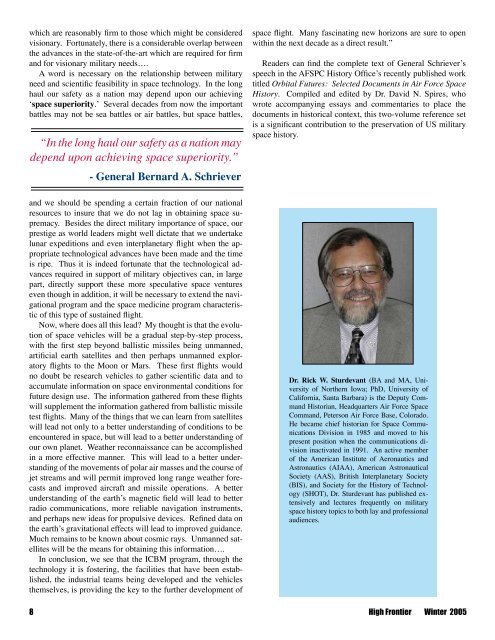Space Superiority
Space Superiority
Space Superiority
You also want an ePaper? Increase the reach of your titles
YUMPU automatically turns print PDFs into web optimized ePapers that Google loves.
which are reasonably firm to those which might be considered<br />
visionary. Fortunately, there is a considerable overlap between<br />
the advances in the state-of-the-art which are required for firm<br />
and for visionary military needs….<br />
A word is necessary on the relationship between military<br />
need and scientific feasibility in space technology. In the long<br />
haul our safety as a nation may depend upon our achieving<br />
‘space superiority.’ Several decades from now the important<br />
battles may not be sea battles or air battles, but space battles,<br />
“In the long haul our safety as a nation may<br />
depend upon achieving space superiority.”<br />
- General Bernard A. Schriever<br />
space flight. Many fascinating new horizons are sure to open<br />
within the next decade as a direct result.”<br />
Readers can find the complete text of General Schriever’s<br />
speech in the AFSPC History Office’s recently published work<br />
titled Orbital Futures: Selected Documents in Air Force <strong>Space</strong><br />
History. Compiled and edited by Dr. David N. Spires, who<br />
wrote accompanying essays and commentaries to place the<br />
documents in historical context, this two-volume reference set<br />
is a significant contribution to the preservation of US military<br />
space history.<br />
and we should be spending a certain fraction of our national<br />
resources to insure that we do not lag in obtaining space supremacy.<br />
Besides the direct military importance of space, our<br />
prestige as world leaders might well dictate that we undertake<br />
lunar expeditions and even interplanetary flight when the appropriate<br />
technological advances have been made and the time<br />
is ripe. Thus it is indeed fortunate that the technological advances<br />
required in support of military objectives can, in large<br />
part, directly support these more speculative space ventures<br />
even though in addition, it will be necessary to extend the navigational<br />
program and the space medicine program characteristic<br />
of this type of sustained flight.<br />
Now, where does all this lead? My thought is that the evolution<br />
of space vehicles will be a gradual step-by-step process,<br />
with the first step beyond ballistic missiles being unmanned,<br />
artificial earth satellites and then perhaps unmanned exploratory<br />
flights to the Moon or Mars. These first flights would<br />
no doubt be research vehicles to gather scientific data and to<br />
accumulate information on space environmental conditions for<br />
future design use. The information gathered from these flights<br />
will supplement the information gathered from ballistic missile<br />
test flights. Many of the things that we can learn from satellites<br />
will lead not only to a better understanding of conditions to be<br />
encountered in space, but will lead to a better understanding of<br />
our own planet. Weather reconnaissance can be accomplished<br />
in a more effective manner. This will lead to a better understanding<br />
of the movements of polar air masses and the course of<br />
jet streams and will permit improved long range weather forecasts<br />
and improved aircraft and missile operations. A better<br />
understanding of the earth’s magnetic field will lead to better<br />
radio communications, more reliable navigation instruments,<br />
and perhaps new ideas for propulsive devices. Refined data on<br />
the earth’s gravitational effects will lead to improved guidance.<br />
Much remains to be known about cosmic rays. Unmanned satellites<br />
will be the means for obtaining this information….<br />
In conclusion, we see that the ICBM program, through the<br />
technology it is fostering, the facilities that have been established,<br />
the industrial teams being developed and the vehicles<br />
themselves, is providing the key to the further development of<br />
Dr. Rick W. Sturdevant (BA and MA, University<br />
of Northern Iowa; PhD, University of<br />
California, Santa Barbara) is the Deputy Command<br />
Historian, Headquarters Air Force <strong>Space</strong><br />
Command, Peterson Air Force Base, Colorado.<br />
He became chief historian for <strong>Space</strong> Communications<br />
Division in 1985 and moved to his<br />
present position when the communications division<br />
inactivated in 1991. An active member<br />
of the American Institute of Aeronautics and<br />
Astronautics (AIAA), American Astronautical<br />
Society (AAS), British Interplanetary Society<br />
(BIS), and Society for the History of Technology<br />
(SHOT), Dr. Sturdevant has published extensively<br />
and lectures frequently on military<br />
space history topics to both lay and professional<br />
audiences.<br />
High Frontier Winter 2005

















